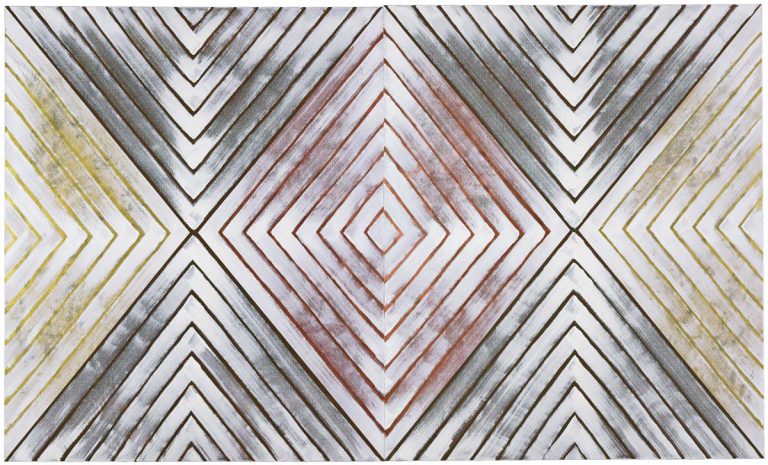We acknowledge the Traditional Owners of the land on which the Queensland Art Gallery | Gallery of Modern Art stands and recognise the creative contribution First Australians make to the art and culture of this country.

Gordon Bennett / Australia 1955—2014 / Number twelve 2007 / Left panel: 183 x 152cm; right panel: 183 x 152cm / Synthetic polymer paint on linen / The James C. Sourris AM Collection / Gift of James C. Sourris through the Queensland Art Gallery Foundation 2010 / Donated through the Australian Government’s Cultural Gifts Program / Collection: Queensland Art Gallery | Gallery of Modern Art / © The Estate of Gordon Bennett
Gordon BennettNumber twelve 2007
On Display: QAG, Watermall
Gordon Bennett’s abstract paintings often employ continuous horizontal and vertical brushstrokes, as well as chevron patterns, and were made in a range of sizes, colours and mediums. While aiming to avoid direct symbolism, Bennett’s stripe paintings remain open to a range of interpretations.
In keeping with Bennett’s strategy of appropriation, one acknowledged reference in these works is the American Frank Stella’s so-called ‘black paintings’ of the 1950s and 60s. Bennett may have been attracted by the ambiguity of Stella’s assertion that his chevron paintings were purely formal and abstract, while their titles evoked Nazi histories and the predominantly black neighbourhoods of New York.
If Bennett’s turn to abstraction is sometimes seen as a shift within his practice, his questioning of the authority of ideas behind Western abstraction and its drive towards purity was an ongoing concern, evident in his early and continuing allusions to European artists such as Kazimir Malevich, Piet Mondrian and George Baselitz. He was also interested in non-Western forms of abstraction, as works such as his watercolour crosshatchings reveal.
Gordon Bennett was born in 1955 in the central Queensland town of Monto. Bennett ‘discovered’ his Aboriginality at the age of eleven. The explicit imagery in his paintings concentrates on his Indigenous heritage, the Eurocentric schooling he experienced, the subjectivity of history, patriarchal knowledge systems and racism.
Bennett attended the Queensland College of Art in Brisbane and completed a Fine Arts Degree in 1988. He had already begun exhibiting his large, semi-autobiographical paintings the previous year in group exhibitions at THAT Contemporary Art Space in Brisbane and the Museum of Contemporary Art in Sydney.
From the time he graduated from art college, Bennett’s work displayed a high level of maturity and a clear sense of direction, but it also flagged his intention to resist certain expectations or categorisations of him as a particular ‘kind’ of artist. He remained uncomfortable with terms such as ‘urban’ or Aboriginal artist, for example, throughout his career, as he consistently drew on imagery and references from Indigenous and Western approaches to art, rather than a preference for one over the other.